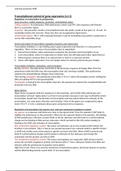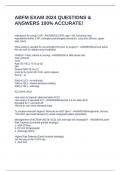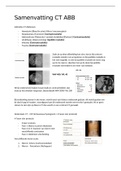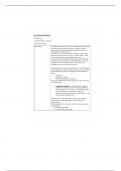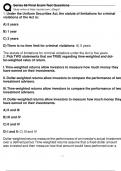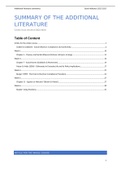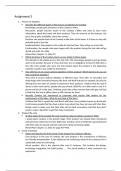Section 1: Establishing and consolidating communist rule in GDR 1949-61
Key words Section 1: Why did events 1945-1949 lead to the division of Germany?
Issues over reparations: the USSR demanded reparations, which were regarded by the allies as
Class struggle excessive and likely to hamper Germany’s economic recovery. The allies believed that a weak
economy and low living standards would increase the appeal for communism.
Eastern bloc Bizonia: in January 1949, after almost a year of secret negotiations, the US and British governments
announced their decision to merge their zones into one economic unit that became known as
Containment Bizonia.
Containment and the Truman Doctrine: In March 1949, Truman announced his policy of
Marshall Plan containment (a key principle to prevent communism spreading) and what became known as the
Truman Doctrine. Three months later, the USA announced significant amounts of financial aid for
NATO war damaged Europe with the Marshall plan.
The Creation of the SED party: On 30th April 1945, just days before the end of the war a group of
German communists led by Walter Ulbricht arrived in Berlin. Their first priority was to try to ensure
that the KPD controlled as many key local administrative positions and to encourage support.
However, it was clear that the SPD had far more popular support than the KPD. This was due to
intense anti-Soviet propaganda of the Nazi government, and the Soviet Army’s widespread looting
and raping of German women that had occurred during the final months of WW2. In April 1946,
600,000 KDP members and nearly 700,000 members of the SPD merged to form the Socialist Unity
Party of Germany (SED). This put pressure on the SPD to disband. The SED swiftly ensured that the
new party was dominated by communists. There was a purge of SED members who had been former
politicians and supporters of the pre-Second World War SPD. In 1948, only 2 years after its formation
the SED officially stated its commitment to Marxist-Leninist principles. By 1950, 5000 former SPD
members had been arrested and sent to Soviet prisons.
The Berlin Airlift: Six days after the new currency was introduced into Bizonia, a serious crisis
developed over Berlin that would severely test relations between the superpowers. On 23 June, the
USSR severed all rail, road and canal links from West Berlin to Western zones. The Western allies
were faced with the problem of how to maintain access to West Berlin and supply food, fuel and
medical supplies to its population of 2 million. The airlift began on 26 June and its height, aircraft
landed in West Berlin every 90 seconds and delivered 8,000 tonnes of supplies each day. For those
living in West Berlin, the blockade meant almost a year of scarce supplies and frequent Soviet
propaganda that Western powers were suddenly going to abandon the airlift. Eventually, in May
1949, after 322 days, more than 277,000 flights and five million packages of charity donations from
the US public, Stalin called off the blockade.
Creation of the FRG: Within the Western zones there was considerable support for Konrad
Adenauer, the leader of the new Christian Democratic Union (CDU) political party. He supported the
rapid setting up of a West German state, fully integrated with the West, even if, in the process, it
meant sacrificing the Soviet zone of occupation. Whereas, in the very immediate post-war years, it
had been the USSR implementing the most radical changes within occupied Germany, it was now the
Western Allies who were pressing ahead to be the first to set up a new state out of their zones of
occupation. The new West German state came into existence in May 1949 as the Federal Republic of
Germany, and Adenauer was elected its first chancellor that summer.
Creation of the GDR: after the setting up of the FRG, a meeting in Moscow in August 1949 made
arrangements for a German state to be established. The GDR was formally set up in October 1949
where Ulbricht became First Secretary of the SED. Only the USSR, the Eastern Bloc and North Korea
would enter diplomatic relations with the GDR.
Proportional Section 2: To what extent was the system of government in the GDR democratic?
representation The structure of Government: The head of state: initially the GDR constitution included a head of
state, known as president or prime minister, but with a purely ceremonial role.
Democratic The Volkskammer (People’s Chamber): originally elections were to be held every four years, the first
centralism elections were held in 1952, but the 500 members of the Volkskammer were not elected in the
Western sense of democracy. The GDR allowed other political parties such as the Liberal Democratic
Party and the Farmers’ Party. This gave an outward appearance of democracy, but the number of
seats was determined by the SED before elections, so the actual outcome was already decided. The
Volkskammer also included representatives of the mass organisations, such as Free German Youth,
Key words Section 1: Why did events 1945-1949 lead to the division of Germany?
Issues over reparations: the USSR demanded reparations, which were regarded by the allies as
Class struggle excessive and likely to hamper Germany’s economic recovery. The allies believed that a weak
economy and low living standards would increase the appeal for communism.
Eastern bloc Bizonia: in January 1949, after almost a year of secret negotiations, the US and British governments
announced their decision to merge their zones into one economic unit that became known as
Containment Bizonia.
Containment and the Truman Doctrine: In March 1949, Truman announced his policy of
Marshall Plan containment (a key principle to prevent communism spreading) and what became known as the
Truman Doctrine. Three months later, the USA announced significant amounts of financial aid for
NATO war damaged Europe with the Marshall plan.
The Creation of the SED party: On 30th April 1945, just days before the end of the war a group of
German communists led by Walter Ulbricht arrived in Berlin. Their first priority was to try to ensure
that the KPD controlled as many key local administrative positions and to encourage support.
However, it was clear that the SPD had far more popular support than the KPD. This was due to
intense anti-Soviet propaganda of the Nazi government, and the Soviet Army’s widespread looting
and raping of German women that had occurred during the final months of WW2. In April 1946,
600,000 KDP members and nearly 700,000 members of the SPD merged to form the Socialist Unity
Party of Germany (SED). This put pressure on the SPD to disband. The SED swiftly ensured that the
new party was dominated by communists. There was a purge of SED members who had been former
politicians and supporters of the pre-Second World War SPD. In 1948, only 2 years after its formation
the SED officially stated its commitment to Marxist-Leninist principles. By 1950, 5000 former SPD
members had been arrested and sent to Soviet prisons.
The Berlin Airlift: Six days after the new currency was introduced into Bizonia, a serious crisis
developed over Berlin that would severely test relations between the superpowers. On 23 June, the
USSR severed all rail, road and canal links from West Berlin to Western zones. The Western allies
were faced with the problem of how to maintain access to West Berlin and supply food, fuel and
medical supplies to its population of 2 million. The airlift began on 26 June and its height, aircraft
landed in West Berlin every 90 seconds and delivered 8,000 tonnes of supplies each day. For those
living in West Berlin, the blockade meant almost a year of scarce supplies and frequent Soviet
propaganda that Western powers were suddenly going to abandon the airlift. Eventually, in May
1949, after 322 days, more than 277,000 flights and five million packages of charity donations from
the US public, Stalin called off the blockade.
Creation of the FRG: Within the Western zones there was considerable support for Konrad
Adenauer, the leader of the new Christian Democratic Union (CDU) political party. He supported the
rapid setting up of a West German state, fully integrated with the West, even if, in the process, it
meant sacrificing the Soviet zone of occupation. Whereas, in the very immediate post-war years, it
had been the USSR implementing the most radical changes within occupied Germany, it was now the
Western Allies who were pressing ahead to be the first to set up a new state out of their zones of
occupation. The new West German state came into existence in May 1949 as the Federal Republic of
Germany, and Adenauer was elected its first chancellor that summer.
Creation of the GDR: after the setting up of the FRG, a meeting in Moscow in August 1949 made
arrangements for a German state to be established. The GDR was formally set up in October 1949
where Ulbricht became First Secretary of the SED. Only the USSR, the Eastern Bloc and North Korea
would enter diplomatic relations with the GDR.
Proportional Section 2: To what extent was the system of government in the GDR democratic?
representation The structure of Government: The head of state: initially the GDR constitution included a head of
state, known as president or prime minister, but with a purely ceremonial role.
Democratic The Volkskammer (People’s Chamber): originally elections were to be held every four years, the first
centralism elections were held in 1952, but the 500 members of the Volkskammer were not elected in the
Western sense of democracy. The GDR allowed other political parties such as the Liberal Democratic
Party and the Farmers’ Party. This gave an outward appearance of democracy, but the number of
seats was determined by the SED before elections, so the actual outcome was already decided. The
Volkskammer also included representatives of the mass organisations, such as Free German Youth,

